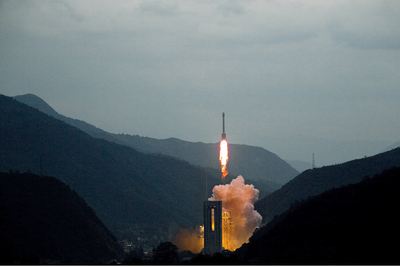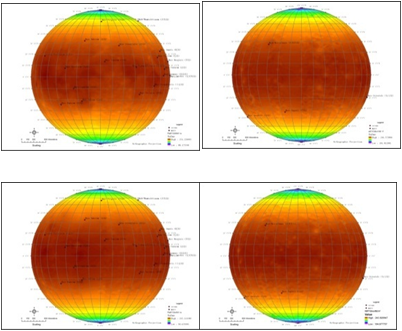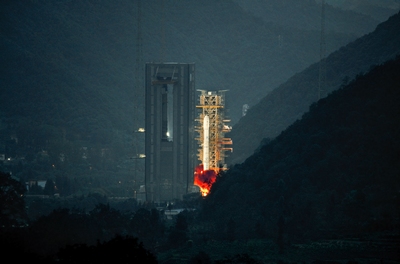NSSC is one of the institutes that initiated and participates in research related to China's Lunar Exploration Program. In general, it is responsible for scientific payload development for the Lunar Exploration Program. Over the years, NSSC has undertaken related tasks such as mission planning, system design and scientific payloaddevelopment for the Chang’e-1, Chang’e-2 and Chang’e-3 missions. In addition, NSSC is in charge of all space weatherforecasting, both during and in advance of missions.
l stereo camera and Sagnac-based interferometer spectrometer imager,
l laser altimeter
l microwave radiometer
l Gamma and X-ray spectrometer system
l space environment monitor system.
In order to collect, process, store and transmit the payloads’ scientific data, a special payload data management system is also included.
To be more specific, the stereo camera and laser altimeter are used to obtain the lunar surface's three-dimensional image; The Sagnac-based interferometer spectrometer imager, the Gamma and X-ray spectrometer system are designed to analyze the contents of useful elements on the lunar surface and the characteristics of the material distribution; while the microwave radiometer surveys the thickness of lunar soil and the space environment monitor system is in charge of surveying the Earth-Moon space environment

the launch of Chang'E 2 on Oct.1, 2010. (Image Courtesy: GONG Jiancun)
Stereo camera and spectrometer imager
The stereo camera can get the nadir, forward, and backward view of the moon. As the spacecraft moves, three two-dimensional lunar surface maps will be acquired. And after data processing, a stereo image of the lunar surface could be obtained.
The stereo camera consists of an optics subsystem, a framework to support optics lens, a plane CCD array and a corresponding signal processing subsystem. The three parallel rows of the plane CCD arrays can get the nadir, forward (17o), backward (-17o) view of the moon as the spacecraft moves forward. The image spatial resolution of stereo camera is about 120m and the swath width is about 60km.
The Sagnac-based interferometer spectrometer imager is designed to get the multispectral image of lunar surface. It contains three major optical subsystems: a Sagnac interferometer, which produces the spatially modulated interferogram; a Fourier transform lens, which frees the spectral properties of dependence on aperture geometry and enables the wide field of view; and a cylindrical lens, which re-images one axis of the input aperture onto the CCD arrays. The image spatial resolution of Sagnac-based interferometer spectrometer imager is about 200m.
Laser altimeter system
Laser altimeter system is designed to measure the distance from the spacecraft to the nadir point of the lunar surface. The laser altimeter system consists of a laser transmitter and a laser receiver. The transmitter emits laser pulses to the lunar surface, and the receiver, which includes a telescope, receives the reflected pulse. The travel time of a pulse gives the information of the distance between satellite and the lunar surface.
The laser altimeter will use infrared ray (1064 nm wavelength) and have a diameter of approximately 120 meters when it intersected the lunar surface.
Gamma and X-ray spectrometer system
Gamma and X-ray spectrometer system is designed to map the elemental abundances of the lunar crust.
The substance on lunar surface will radiate Gamma ray when they are under the cosmic ray irradiation. And other elements with natural radioactivity can emit Gamma ray by themselves, such as K., Th. and so on. The Gamma rays radiated by different elements differ with each other on energy intensity. So by measuring the flux and energy intensity of these Gamma rays, scientists can deduce the elemental abundances of the lunar crust.
X ray spectrometer is similar to Gamma ray spectrometer. It can measure the flux and energy intensity of X rays emitted from lunar surface substance. The X rays with energy between 0.5Kev and 60Kev can be detected. So Gamma ray spectrometer and x ray spectrometer are complementary with each other.
Microwave radiometer
Microwave radiometer system is designed to survey the thickness of lunar soil.
Microwave radiometer uses 4 different microwave bands to get the radiation of the lunar surface. The receivers can survey the radiate brightness temperature of lunar surface, and the temperature resolution is about 0.5K.
The brightness temperature radiation received by receivers consists of two parts, one part is radiated by lunar soil and other part is radiated by lunar rock.
The radiation intensity is the function of dielectric constant, temperature, wave frequency, soil thickness, surveying angle. By surveying the radiate brightness temperature, scientists can get the thickness of lunar surface soil. 4 frequencies: 3GHz, 8GHz, 20GHz, and 37GHz are chosen for microwave radiometer receivers. The expected penetration thickness of wave at these frequencies is about 30m, 20m, 10m and 1m respectively when the temperature resolution is 0.5K. Besides the receivers, four calibrating antenna are used to compensate the cosmic radiation.

The first picture of “microwave moon" in the world taken by a 4-band microwave radiometer. (Image by NSSC)
Space Environment Monitor System
The space environment monitor system includes one solar high-energy particle detector and two solar wind ion detectors.
The high-energy particle detector is designed to analyze the heavy ions and protons on the space from the Earth to the Moon and around the Moon. The protons with energy between 4Mev and 400MeV can be detected. The heavy ions, such as He, Li and C, will also be analyzed. The high-energy particle detector consists of 3 sensors and a signal processing subsystem.
The two solar wind detectors are designed to analyze the ions with low energy on the same space with high-energy particle detector. The ions with energy among 0.05Kev and 20Kev can be collected and classified into 48 grades. The solar wind detector consists of a collimator, an ion analyzer and a MCP amplifier.
Payload Data Management System
PDMS is a distributed system based on the 1553B data bus; it consists of Bus Controller (BC), Solid State Recorder (SSR), High Rate Multiplexer (HRM), Remote Terminal (RT) and Power Distributor (PD). Most of the payloads access the system via 1553B data bus. Laser altimeter and space environment monitor system are connected to the RT. PDMS acquire the science and housekeeping data of the payloads through 1553B data bus and store the data in the SSR or inner the payload memories. When the spacecraft pass the ground station access range, the stored data and the real time data will be interpolated and capsulated by the HRM to form a serial of Coded Virtual Channel Data Units (CVCDU) according the CCSDS standard and be transmitted to the Earth. The PDMS is flexible and effective; if any payload retreats from the exploration the others will share its store and transmission resources.



